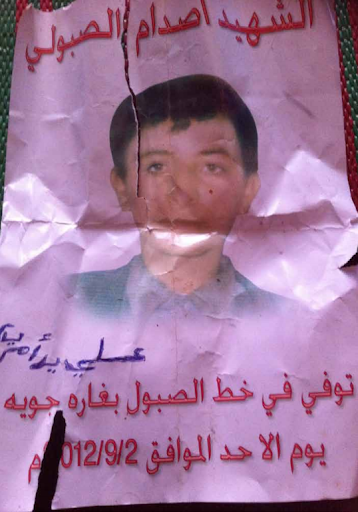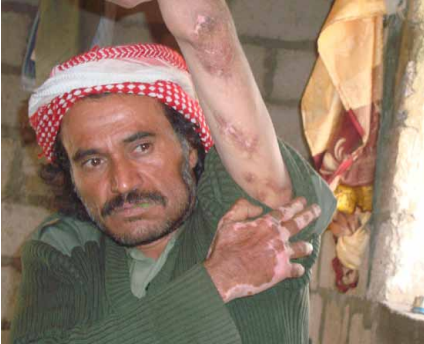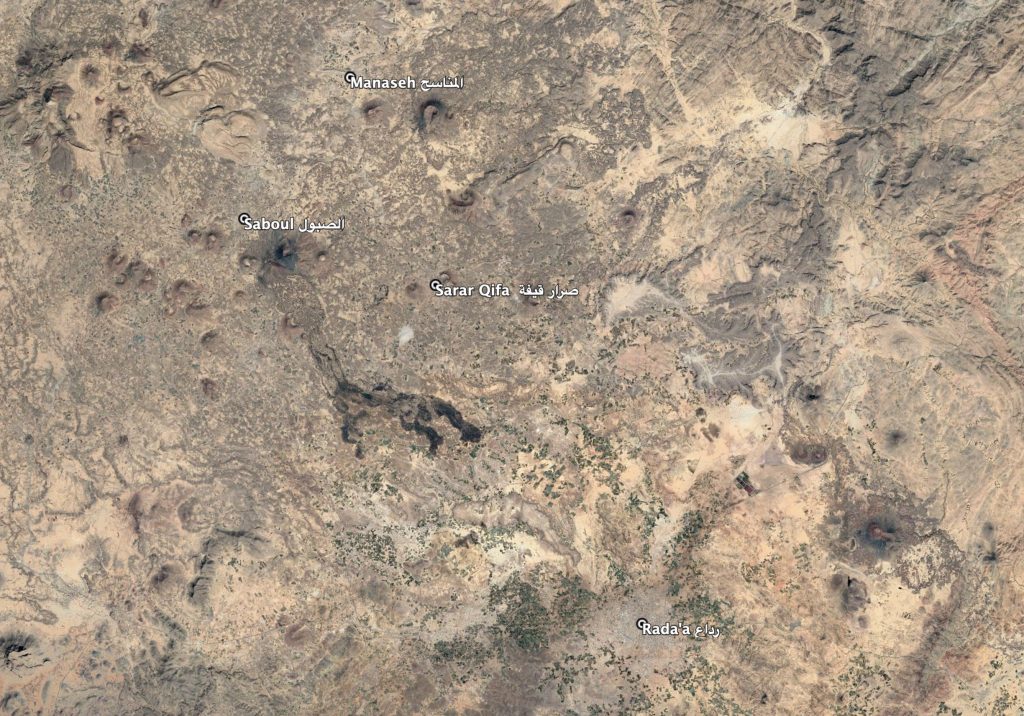Incident Code
Incident Date
Location
Geolocation
Geolocation
Airwars Assessment
(Previous Incident Codes: YEM102USYEM117)
Confirmed US drones or jets killed between 11 and 14 civilians, including up to three women (one pregnant woman) and three children, in a botched attack on an alleged senior militant in the village of Al Saboul in Bayda province at 4pm on September 2, 2012. Up to 11 other civilians were wounded.
Al Masdar Online published the names of those killed: Abdullah Muhammad Ali al-Daqari (23-25 years old), Mubarak Muqbel al-Daqari (13 years old), Nasir Salah (50-60 years old), Rassila Ali (41-55 years old) (Nasir Salah’s wife), Dawlat Nasir (10 years) (Daughter of Nasir Salah), Abdullah Ahmad Abd Rabbo Rabeesh (28 years), Saddam Hussein Muhammad Musaad (18-28 years, student), Ismael Mabkhout Muhammad (25-30 years, farmer), Abd al-Ghani Muhammad Mabkhout (12-17 years, student), Masoud Ali Ahmed Muqbel (45 years old, farmer), Jamal Muhammad Abbad (30 years old).
The injured were listed as the driver Nasser Mabkhout, 45 and Sultan Ahmed Mohammed Sarhan, 27. Mohammed Abdo Jarallah died of his wounds three weeks later after he was transferred to Egypt for treatment. Alkarama, in an October 2013 report, said 11 pedestrians were injured in the strike.
Locals said that a 10-year-old girl, her mother, and her father (Nasir Salah, Rassila Ali and Dawlat Nasir) were killed while returning from a doctor’s visit. Both were corroborated by a report compiled by three human rights groups, submitted to a US Senate subcommittee hearing in April 2013. “The bodies were charred like coal. I could not recognize the faces,” said Ahmed al Sabooli, the dead girl’s 22-year-old brother. “Then I recognized my mother because she was still holding my sister in her lap.That is when I cried” reported Foreign Policy. Mwatana added that Rassila was pregnant at the time she was killed.
Alkarama quoted the father of Mubarak Muqbel al-Daqari, who described him as “Mubarak left school when he was in the sixth grade to work on a farm and help us financially. Everyone loved Mubarak, but his grandfather loved him most of all, and to this day we have not been able to tell him of his death.”
A report by Mwatana pointed out that many of the victim’s families lost their breadwinners in the strike: Mohammed Abdo Jarallah, who was killed in the attack, supported a family of 25. Masoud Ali Muqbel, who was also killed in the strike, had four sons and five daughters, all of whom were forced to leave school and go to work in their father’s farm after his death. Umm Moosa, the wife of Masoud Ali, said: “All my kids are still children. The eldest is 12 years old. For a whole week, my child kept asking, ‘Where is my father?’ and we told him that his father had gone to God. Moreover, my mother-in-law has been sick since her son’s death.”
Mareb Press reported that the dead were from the village of Saboul, and that a number of them were heading to Radaa to sell khat. A provincial police official, tribal officials and local residents said that a minibus was hit by mistake, killing the civilians.
Reports about the number of casualties from the strike were varied, with @AlainOnline tweeting that thirteen civilians were killed in an apparent drone attack, while @7aryaneh tweeted that eleven civilians were killed, but specifically included the details of three women. Kuwaite News @NewsKuwaite later reported that thirteen individuals were killed including a “prominent” al-Qaeda leader. @Akhbar tweeted shortly after that fourteen civilians were “mistakenly” killed in an airstrike.
The airstrike was initially said to have intended to strike a car carrying alleged militant Abdulraouf al Dahab at 4pm local time, with some sources stating that he survived the strike. Abdulraouf’s half-brothers Qayid and Nabil al Dhahab survived a US drone strike in May that year. They reportedly became local Al Qaeda leaders in Radaa after Yemeni intelligence services killed their brother Sheikh Tariq al Dahab in February 2012. Initial reporting from local and international media, including Reuters and Ahram News, reported that as many as 10 members of Al Qaeda were killed in the attack. However, these sources also note that the claims of killing Al Qaeda leaders were being contradicted by other sources.
At first military officials said Yemen Air Force jets killed them as they returned to their village because of faulty intelligence. However the Yemen Air Force lacks the technical capability to carry out a precision strike on a moving target, and the Yemen Post reported that the attack was the work of US drones.
Eyewitnesses also reported that a drone carried out the strike. In December 2012, US officials acknowledged responsibility for the attack. They told the Washington Post a “Defense Department aircraft, either a drone or a fixed-wing warplane” carried out the strike. Witnesses told the paper they saw three aircraft over the strike, two of them Yemeni. “I heard a very loud noise, like thunder,” said Sami al-Ezzi, a farmer who was working in his fields in Sabool, a farming village six miles from Radda. “I looked up and saw two warplanes. One was firing missiles.”
Witnesses also told Human Rights Watch researcher Letta Tayler that drones and jets were over the area on the day of the strike. Their testimony and the shrapnel they recovered from the site pointed to US involvement but could not determine if the drones or strike fighters launched the attack.
Recounting the aftermath of the strike, a local sheikh Nawaf Massoud Awadh told Tayler: “About four people were without heads. Many lost their hands and legs…These were our relatives and friends.”
“Their bodies were burning,” recalled Sultan Ahmed Mohammed, 27, who was riding on the hood of the truck and flew headfirst into a sandy expanse. “How could this happen? None of us were al-Qaeda” reported the Washington Post. “If we are ignored and neglected, I would try to take my revenge. I would even hijack an army pickup, drive it back to my village and hold the soldiers in it hostages,” said Nasser Mabkhoot Mohammed al-Sabooly, the truck’s driver, 45, who suffered burns and bruises. “I would fight along al-Qaeda’s side against whoever was behind this attack.”
The uncle of Mohammed Abdo Jarrallah, who was killed by the attack, told Mwatana: “We were all shocked by the incident. A group of qat vendors and farmers, including a woman and child, who had nothing to do with any [militant] group were killed. Everyone in the area knew them, and so did everyone in Rada’a market. They were coming home carrying home necessities and food for their families. Why did America kill them? What was their crime? Was it their fault that they were poor and they were from a poor and remote village? What is the crime of the victims’ children so that they lose their breadwinner in this horrible way?”
In their submission to a Senate subcommittee hearing, NGOs HOOD, Alkarama and CCR interviewed survivors. One said: “We saw two planes coming close to us. One of them got very close and fired a missile and we flew from the car. Some were still alive, and wanted to flee, but the plane fired another missile to kill those who were not yet dead from the first.”
One of the survivors said: “The plane came very close to us, which enabled them with all certainty to see us and confirm to them that we were civilians and that we had children and women with us.”
The victims’ families, joined in protests by hundreds of others, “vowed to retaliate”. As CNN reported: “Families of the victims closed main roads and vowed to retaliate. Hundreds of angry armed gunmen joined them and gave the government a 48-hour deadline to explain the killings, which took place on Sunday. Eyewitnesses said that families attempted to carry the victims’ corpses to the capital, Sanaa, to lay them in front of the residence of newly elected President Abdurabu Hadi, but were sent back by local security forces.”
Yemen’s government later established a commission of inquiry into the deaths, the worst civilian tally since May. However, three months after the strike, locals complained that “the government is trying to kill the case” and that “the government wants to protect its relations with the US.”
Xinhua reported that a number of MPs “summoned Interior Minister Mohammed Qahtan to an emergency meeting to clarify over the civilian casualties of the U.S. drone strike” and that Minister of Human Rights Houria Mash’hour “condemned the ‘U.S. meddling’ in Yemeni internal affairs, saying that most casualties of the U.S. drones were civilians and calling for an immediate end to the U.S. interference and drone strikes.”
US chief counter-terrorism adviser John Brennan also spoke with President Hadi on September 4, though it is not known if the Radaa strike was discussed.
A BBC report on drone strikes in Yemen later reported that the Yemeni government paid $75,000 (£48,000) in blood money to the families of the victims while Mwatana reported that “in August 2014—nearly two years after the incident—the victims’ families received 7 million riyals (approximately US $32,578) for each family member killed, and 3 million riyals (approximately US $13,962) for each family member injured.”
Due to the nature of both CIA and US military involvement in Yemen, and the lack of official acknowledgement by the CIA for their involvement, Airwars grades this event as “declared” due to the comments made by US government sources to media, in lieu of public reporting on CIA actions.
Victims
Family members (2)
Family members (3)
Individuals


Key Information
Geolocation Notes
The video published by Alkarama mentions the village of Al Saboul (الصبول), for which the coordinates are: 14.5370040, 44.7177870. Other locations mentioned are the town of Rada’a (رداع), Sarar Qifah (صرار قيفة) and the road between the villages of Hama (الحمة) and Manaseh (المناسح). The coordinates for Sarar Qifah (صرار قيفة) are: 14.517317, 44.776728. The coordinates for Rada’a (رداع) are: 14.415088, 44.840937. The coordinates for Manaseh (المناسح) are: 14.579762, 44.750219. There are several villages by the name Hama. On Openstreetmaps Sarar Qifah is referred to as Hammat Sarar.

Al Saboul (الصبول) and Sarar Qifah ( صرار قيفة) between Manaseh (المناسح) and Rada’a (رداع)
Imagery: Google Earth
